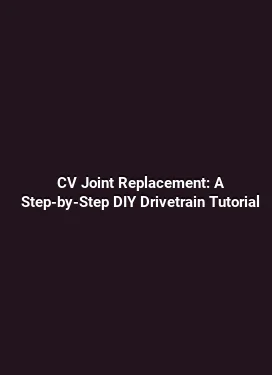How to Install Short Shifter Kit on Mazda Miata for Faster Shifts
Upgrading the manual transmission of a Mazda Miata with a short shifter kit is a popular modification among driving enthusiasts seeking quicker, more precise gear engagement. A well-chosen short shifter reduces the distance the shift lever travels, which translates to faster shift throws and a more engaging driving experience. This guide walks through selecting the right kit, preparing for installation, executing the fitment, and testing the system to ensure reliable operation under daily driving and spirited sessions alike. It emphasizes practical steps, accurate torque practices, and drivetrain considerations to help you achieve consistent performance gains without compromising reliability.
Choosing the Right Short Shifter Kit for Mazda Miata

Before ordering a kit, it’s essential to understand the core concepts that influence feel, longevity, and compatibility. Short shifter kits typically alter the lever length, reduce the throw, or modify the linkage geometry to sharpen engagement. The Miata’s multiple generations share fundamental transmission layouts, but small differences in mounting points, cable routing, and internal shift forks can affect compatibility. A kit that is specifically designed for your generation (NA, NB, NC, or the more recent ND) will usually provide the cleanest fit and the most predictable results.
One of the first decisions is selecting between a welded, solid-shaft design and a modular, replace-the-shifter-without-drivetrain-disassembly approach. A well-engineered kit should maintain or improve the throw reduction while preserving the tactile click of each gear and the factory detents’ positive engagement. Pay attention to the after-purchase risk factors such as potential shift lever play, increased vibration, or minor changes in the clutch feel at low RPM. For many Miata owners, a kit with a polished nickel–chromium finish and robust bushings offers both durability and a crisp, repeatable shift action across a wide temperature range.
Key Factors to Consider

When evaluating options, several practical criteria help distinguish high-quality kits. Fitment, hardware quality, and adjustment range are paramount. Look for kits that include correctly threaded mounting hardware, a precisely machined shifter arm, and bushings designed to resist wear under freeway speeds and canyon braking. The installation manual should clearly map the steps for aligning the selector rod or linkage and specifying torque values that match stock fastener requirements without overloading the mounting points.
In addition, consider the impact on shift throw length. Most kits advertise a percentage reduction, but the real-world effect depends on the stock lever length, the pivot geometry, and the linkage’s alignment. Some drivers report a more direct, almost piano-key feel, while others appreciate a tad more leverage for smoothness at low RPMs. For daily driving, a moderate reduction that preserves a comfortable, controllable shift feel often yields the best balance between speed and accuracy.
Tools, Preparation, and Safety Considerations
Gathering the correct tools before starting is paramount. Typical requirements include metric sockets and wrenches, a torque wrench with precise torque settings, an Allen key set, pliers, screwdrivers, and a trim removal tool for under-dash access. Depending on the model year, you may need a jack and jack stands or a stable lift to relieve the weight from the transmission tunnel area for easier access to the shift linkage and mounting hardware. A couple of shop rags and a mild degreaser help keep the workspace clean, which reduces the risk of misaligned components during reassembly.
Safety comes first in any mechanical modification. Secure the Miata on a level surface and block the wheels to prevent movement. If the transmission is warm, allow it to cool to avoid burns from metal components or exhaust heat near the undercarriage. Always follow the vehicle’s service manual torque specifications and use thread-locking compound only when recommended by the kit manufacturer. A clean workspace and organized parts bin speeds up the process and minimizes the chance of overlooking small fasteners that could rattle loose after road testing.
Preparing the Vehicle
Begin by disconnecting the battery to avoid any accidental electrical contact during dash disassembly. Remove interior panels or trim that obstruct access to the shifter base and the center console. If your generation uses a gear-knob assembly with a leather boot, carefully disconnect any clips or fasteners to prevent tearing. Inspect the original shift linkage for wear signs, such as play in bushings or worn ball joints. Noting these details helps you determine whether to replace affected components or to upgrade them alongside the short shifter kit.
With the console removed, you will gain visibility into the shift pattern linkage. It is crucial to mark or photograph the stock position of the linkage to ensure proper calibration after installing the new shifter. This step reduces the likelihood of misalignment, which can lead to missed gears or binding during shifting. Prepare a clean surface to lay out all fasteners and small parts so none are misplaced during reassembly.
Installation Steps: Step-by-Step Guide
The installation sequence below is designed to be thorough while allowing for checks and adjustments at logical milestones. If the kit includes an instruction sheet, cross-reference it at each stage to verify the order and torque values specific to your Miata variant. Consistency and patience pay off with a precise, reliable shifter that maintains factory safety margins.
Step 1: Access and Remove the Stock Shifter Assembly
Lift the vehicle and locate the shift boot and center console assembly. Remove the boot, then detach the pivot pins or bolts that secure the factory shifter to the linkage or the transmission tunnel. If you encounter resistance from overmolded bushings, apply a light penetrating oil along the joint and allow a few minutes to penetrate before loosening. Once the shifter is free, detach the final mounting bolts and carefully extract the lever assembly, taking care not to damage nearby cables or wires running through the tunnel.
Take note of the shifter’s vertical and lateral orientation. Accurate orientation ensures the replacement lever aligns with the transmission’s internal detents. If you observe wear on the stock mounting points, consider upgrading bushings to minimize future play and to maintain a consistent feel after installation.
Step 2: Install the Short Shifter itself
Position the new short shifter in the same orientation as the stock unit. Begin by threading the mounting hardware loosely to permit micro-adjustments during alignment. Some kits rely on a pin or a retaining clip to secure the lever; ensure that any retaining hardware is fully seated and that there is no binding as the lever moves through its full range of motion. If the kit includes an adjustable linkage, set it to approximate stock geometry and refine later during a test shift session.
Secure the shifter using the provided fasteners, gradually tightening in a cross pattern if multiple bolts are present. Use a torque wrench to apply the manufacturer’s specified torque values. Over-tightening can warp the shifter base or damage the transmission case, while under-tightening may cause looseness and rattle under acceleration. After mounting, manually cycle the lever through all gears to confirm smooth engagement and the absence of contact with surrounding components.
Step 3: Reconnect Linkage and Center Console
Reconnect the shift connector or linkage rods to the new shifter, ensuring there is no binding when moving the lever through its full range. If the kit uses a cable-type linkage, verify proper clamping and alignment to prevent lateral movement during gear changes. Reinstall the center console, ensuring the boot aligns correctly with the shift lever’s new position. The boot’s stance should look natural and not pinch against the lever or surrounding trim.
With the console reattached, the next step is to reinstall panels and reattach the battery. Before performing a road test, do a quick check by shifting through gears with the vehicle on the parking brake and no load on the drivetrain. Listen for unusual noises, verify that each gear engages fully, and ensure there is no interference between the shift lever and the parking brake or other interior components.
Step 4: Fine-Tuning and Break-In
After the initial installation, a brief break-in period helps the bushings bed in and the lever achieve consistent resistance characteristics. Gentle, non-winding shifts during the first 50–100 miles are often recommended. Avoid aggressive, high-RPM shifts during this period to prevent premature wear on the shift mechanism. As part of the break-in, test the full range of motion at moderate engine speeds to confirm the feel remains steady under different temperatures and driving conditions.
Post break-in, you can perform a final adjustment to the linkage if your kit allows it. If the shifter initially feels too stiff or too loose in particular gears, micro-adjust the linkage or mounting position to achieve an even engagement across all gears. This step is essential for ensuring the shift throw is consistent from first to fifth gear without creating binding hotspots at any specific position.
Performance Tuning, Maintenance, and Real-World Use
Installing a short shifter kit is not solely a matter of quick shifts in a straight line. A well-executed upgrade can improve precision, reduce driver fatigue, and enhance the overall driving experience. The key is to balance the improved lever action with the Miata’s well-known chassis balance and the engine’s torque delivery characteristics. Expect crisper, shorter throws that allow more confident, rapid gear selection during spirited cornering or track-day sessions, while maintaining a comfortable feel for daily driving.
In terms of maintenance, inspect the shifter base and linkage during routine service intervals. Look for signs of wear, such as movement in bushings or looseness at fasteners. If the kit includes upgraded bushings, monitor them for deformation or cracking, especially after heat cycles or repeated aggressive shifting. Keep the linkage lubricated as recommended by the kit manufacturer, but avoid over-lubing, which can attract dirt and accelerate wear. A periodic check of mounting hardware ensures the system remains secure and free of rattles as the vehicle accumulates mileage.
From a drivability perspective, you may notice a slight increase in pedal effort at the clutch when shifting rapidly due to the closer gear engagement and faster shifts. Depending on your clutch setup and RPM range, you might choose to adjust clutch engagement points or reinforce the flywheel alignment to maintain smooth transitions. For competitive driving, pairing the short shifter with a properly tuned clutch and a refined shift pattern contributes to a more consistent lap time and improved control in demanding corners.
Common Scenarios and Practical Tips
Ya short shifter installations yield the greatest benefits in tight, twisty road sections or track sessions where quick, accurate gear changes are paramount. To maximize reliability, verify the kit’s compatibility with drive-by-wire or mechanical throttle systems if applicable, and confirm that the transmission’s internal detents remain within factory tolerances. Some owners report a more direct response in the upper gears, while others notice improvements most pronounced in downshifts, where a precise mapping of the linkage allows for quicker rev-matching under heel-and-toe techniques.
In daily driving, a well-implemented short shifter can reduce the frequency of missed gears, particularly during rapid cadence shifts. It can also reduce driver fatigue by lowering the effort required to complete each shift sequence. If you drive in hot climates or under heavy traffic, ensure that the linkage does not bind at elevated temperatures and that the lever remains comfortably within reach in all seating positions. Lastly, keep an eye on the boot and trim around the shifter to prevent wear caused by the increased lever activity over time.
Performance Verification: Road Test and Diagnostics
With the installation complete, conduct a structured road test to evaluate the improvement qualitatively and quantitatively. Start in a controlled environment with minimal traffic. Shift through all gears at varying engine speeds, paying attention to alignment, detent feel, and any unusual vibrations. Document the time taken to shift from gear to gear during a controlled crawl and compare it with your baseline data. While a direct numeric delta may be difficult to measure in casual settings, the perceived gain in shift speed and cadence is a strong indicator of success.
If any gear binding or missed shifts occur, recheck linkage alignment, ensure the mounting hardware is torqued to spec, and confirm that there is no interference with nearby components. Adjust the linkage angle within the kit’s acceptable range to restore smooth engagement. Real-world reliability often hinges on minor adjustments and the attention given to safeties such as proper boot seating and secure trim panels.
Conclusion: What to Expect After Installation
The Mazda Miata benefits from a well-matched short shifter kit through improved shift precision, reduced throw distance, and enhanced driver confidence. The upgrade complements the Miata’s nimble handling by delivering a more direct connection between the driver and the transmission. While the primary benefit is faster shifts, the cumulative effect—especially in track-ready configurations—can include quicker lap times, reduced driver fatigue, and a more engaging ownership experience. With careful selection, meticulous installation, and disciplined testing, a short shifter can be a durable, high-value upgrade that complements the Miata’s renowned driving dynamics.






